Rangers fans would have feared the worst.
Having lost twice already to Celtic this season, the Teddy Bears have been miles off their rivals.
Before this match, Rangers trailed Celtic by 14 points and had been poor over the Christmas period.
Just 18 days after the last Old Firm, where Celtic clinched the League Cup, Rangers were in horrible form.
Losing to St Mirren on boxing day and a draw against Motherwell had put Philippe Clement under considerable pressure.
Many couldn’t have predicted how the match would play out.
Celtic were rocked by the intensity Rangers played with in the first half.
Ianis Hagi scored the opening goal from distance in the first 10 minutes.
The Hoops were on the ropes, struggling to match high-tempo Rangers.
The second half saw little difference.
The Gers were relentless.
Pröpper poked home Rangers’ second after reacting first to a Kasper Schmeichel save.
Then, in the 81st minute, substitute Danilo sealed the game, scoring with his first touch.
This was a game that Rangers dominated.
It was also a game where Celtic were uncharacteristically poor.
This post-match analysis will consider the areas where Rangers thrived and highlight the areas where Celtic failed to impact the game.
Rangers Vs Celtic Lineups
Rangers’ form wasn’t the only reason that they had their worries before this match.
Their defence was without regulars James Tavernier, John Souttar, Leon Balogun and goalkeeper Jack Butland.
Backup goalkeeper Liam Kelly was between the sticks for only his second appearance.
Left-back Rıdvan Yılmaz had to play on the opposite flank, filling in at right-back.
Dujon Sterling and Robin Pröpper formed the centre-back partnership, while Jefté continued at left-back.
The midfield and forward line remained unchanged from the League Cup final.
Mohamed Diomande and Nicolas Raskin operated as the deeper midfield players.
Nedim Bajrami, Ianis Hagi, Václav Černý and Hamza Igamane made up the attack quartet.
Celtic had only one change from their League Cup final.
Kasper Schmeichel started in nets behind right-back Alistair Johnston.
Cameron Carter-Vickers was partnered with Liam Scales, who was the only change from the previous Old Firm.
Greg Taylor remained at left-back.
The midfield three was made up of Callum McGregor as the ‘number 6’, with Paulo Bernardo and Reo Hatate operating as 8’s
The Celtic forward line was made up of Kyogo Furuhashi, Nicolas-Gerrit Kühn and Daizen Maeda.
Rangers Mid-Block
Rangers’ defensive resilience was displayed during the League Cup final.
Philippe Clement set his side up in a mid-block to prevent Celtic from playing forward into midfield.
This tactic was used effectively again.
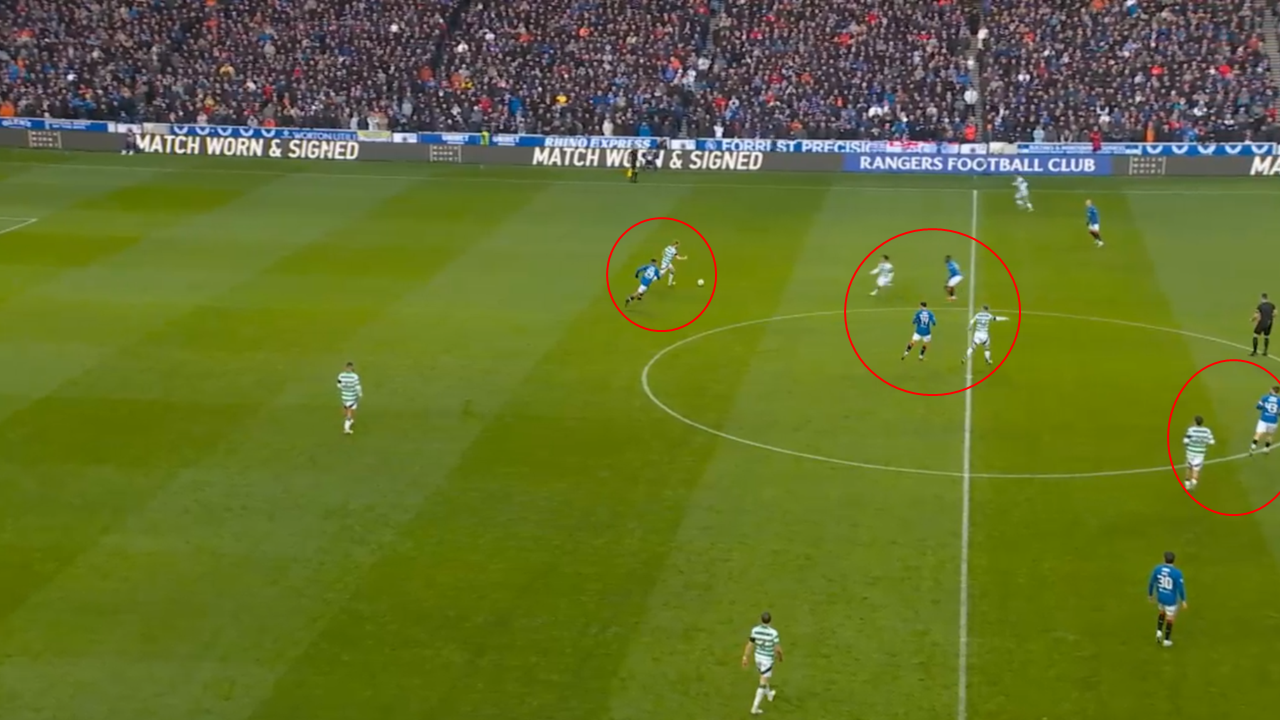
Here, we can see the setup clearly.
Rangers set up with forward Hamza Igamane pressing either centre-back as the Bhoys began the build-up phase.
In midfield, Rangers operated a man-to-man marking system.
Bajrami was tasked with man-marking deep-lying playmaker Callum McGregor.
Diomande and Raskin were responsible for sticking tightly to Celtic’s two number 8s.
As Celtic’s centre-backs would progress with the ball, Igamane would cut off the potential for the opposite centre-half to be an option.
The Moroccan striker forced Celtic’s build-up play one way, and Rangers’ man-to-man marking system gave Carter-Vickers and Liam Scales very few options on the ball.
For Rangers first goal, this scenario played out.
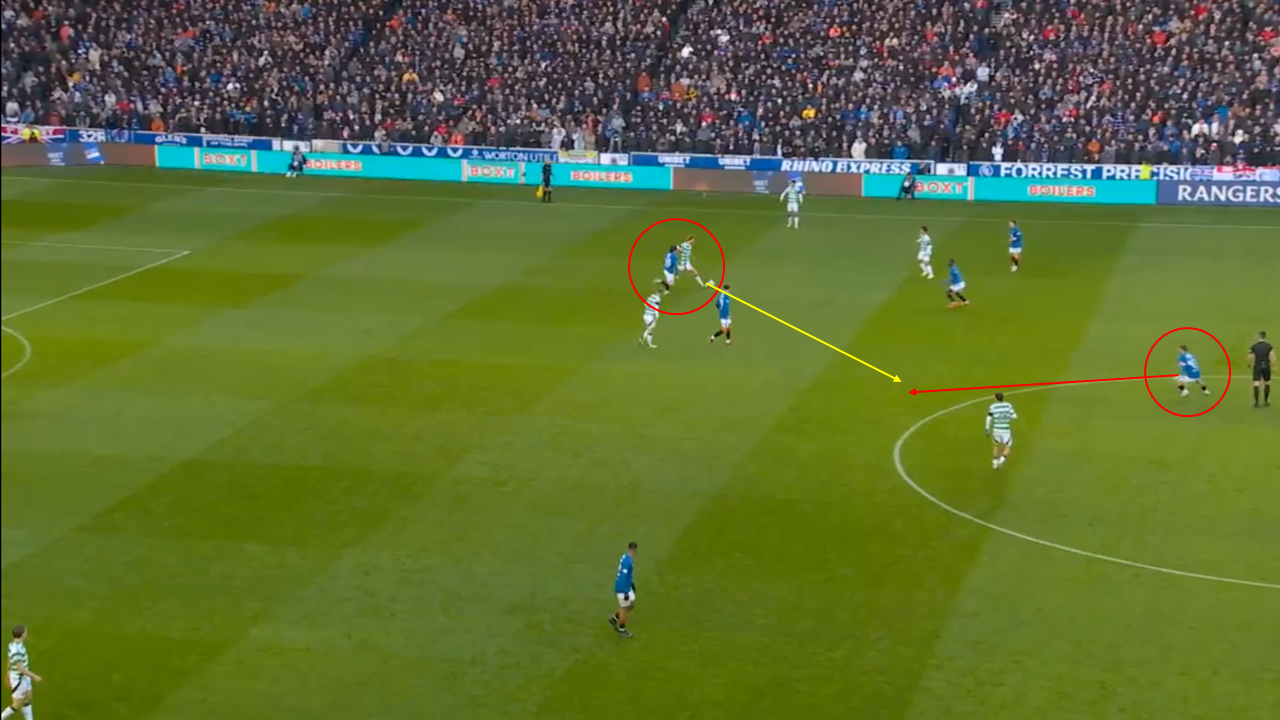
Scales has limited options due to Bajrami taking over the role of his forward, Igamane, forcing play out wide.
He tries an intricate reverse pass into midfield.
However, captain Raskin has read the Irishman’s pass.
He steps in and makes an interception that begins the attack for the first goal.
Rangers Regains Map
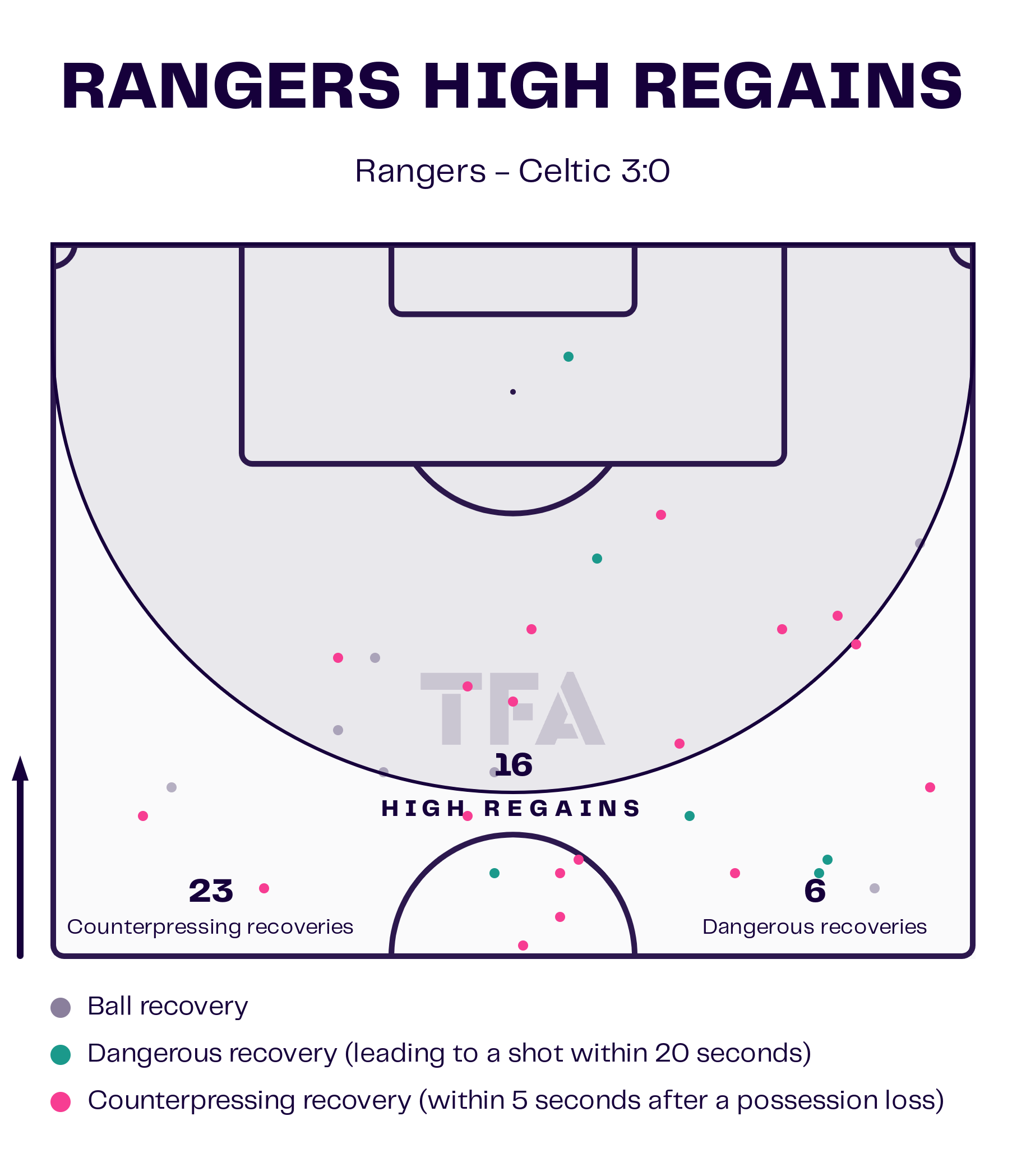
As seen from this regains map of the pitch, Rangers made a significant number of their recoveries in the middle section of the pitch.
The individual performance of the midfield duo Raskin and Diomande were a key part of this.
The pair had a combined total of five interceptions and six tackles.
The pair also both won over 60% of their duels.
High Pressing
Adopting the mid-block was a sensible and calculated approach for Rangers to take.
Brendan Rodgers has formed a side that is more than capable of outplaying the most aggressive of presses.
Rangers’ timing of when they pressed was key.
One trigger was when the ball was played backwards.
Collectively, Rangers would invade Celtic’s defensive third as a pass was played backwards.
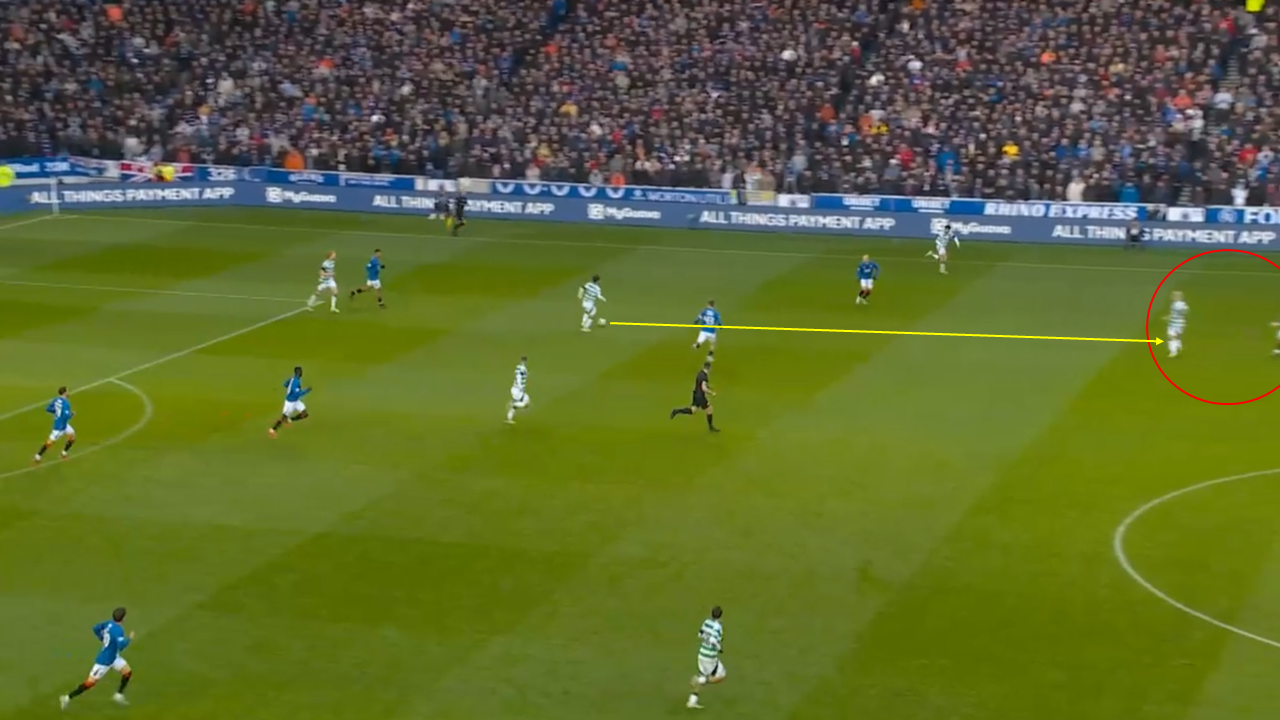
In this situation, Celtic played a number of passes under severe pressure.
Rangers have pressed high after a backwards Celtic pass and are trying to force a mistake.
Still, implementing a man-to-man pressing structure, Yılmaz remains tight to Maeda.
As Meda drops to offer an option to beat Rangers’ aggressive press, the Turkish full-back steps in front of his man and wins the ball back.
Another trigger was forward Igamane’s aggressive pressing in Celtic’s third, putting Scales and Carter-Vickers under immediate pressure.
With limited options, Rangers midfield would push higher, waiting to pounce on their opponent’s mistakes.
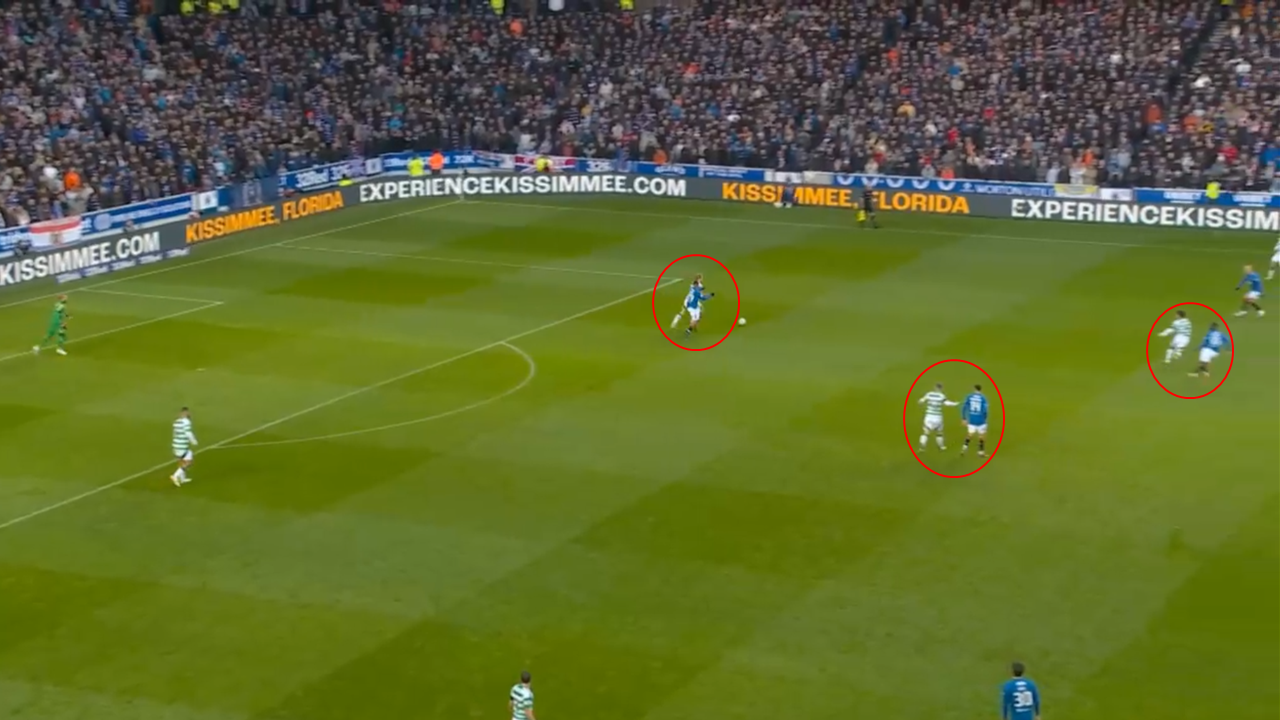
Here, Scales is under immense pressure from Igamane.
Celtic’s midfield drops to offer a supporting angle, but their opponents follow them closely, preventing an easy pass forward.
Rangers also excelled during the counterpress.
They completed 23 counterpressing recoveries.
This was key to their ability to put Celtic under sustained pressure.
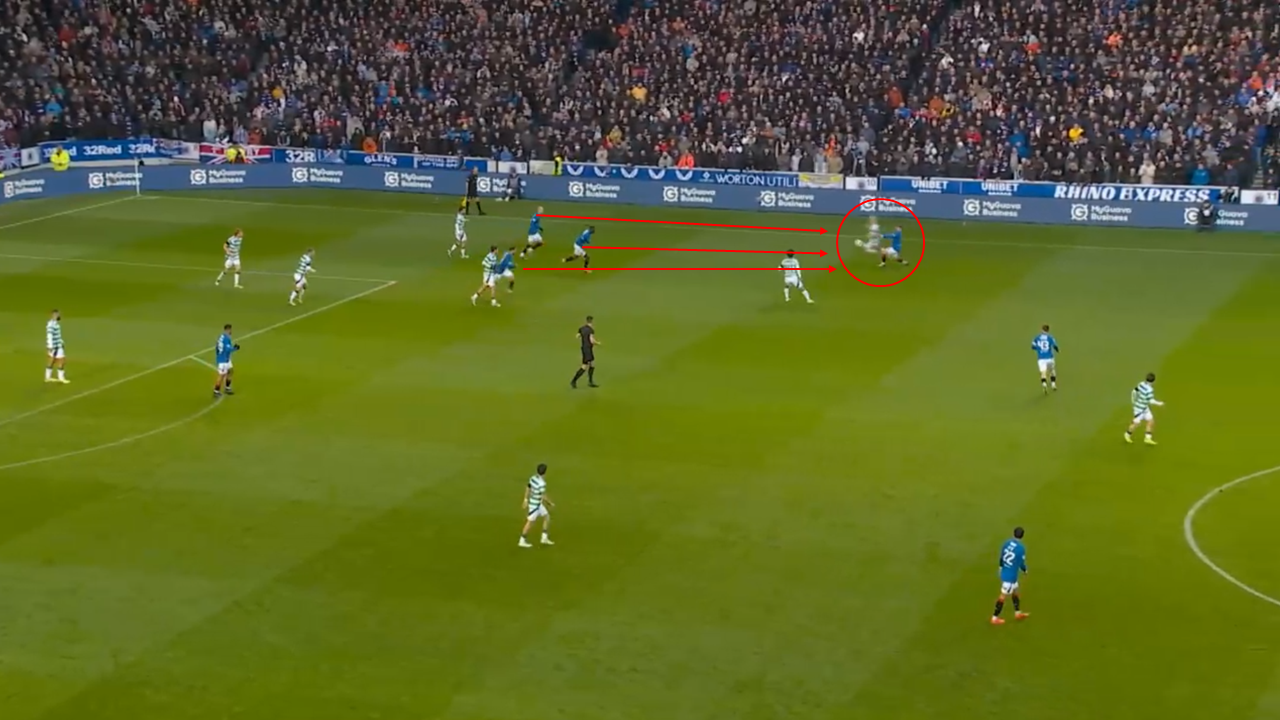
In this situation, Rangers lost the ball in the final third.
Celtic’s first pass forward finds Maeda, who’s dropped incredibly deep.
He’s then swarmed by blue shirts and loses possession.
Rangers Fast Attacks
Once Rangers had won the ball back, they then had the platform to go and put Celtic under pressure.
They opted to play forward as quickly as they possibly could.
This started from goalkeeper Liam Kelly.
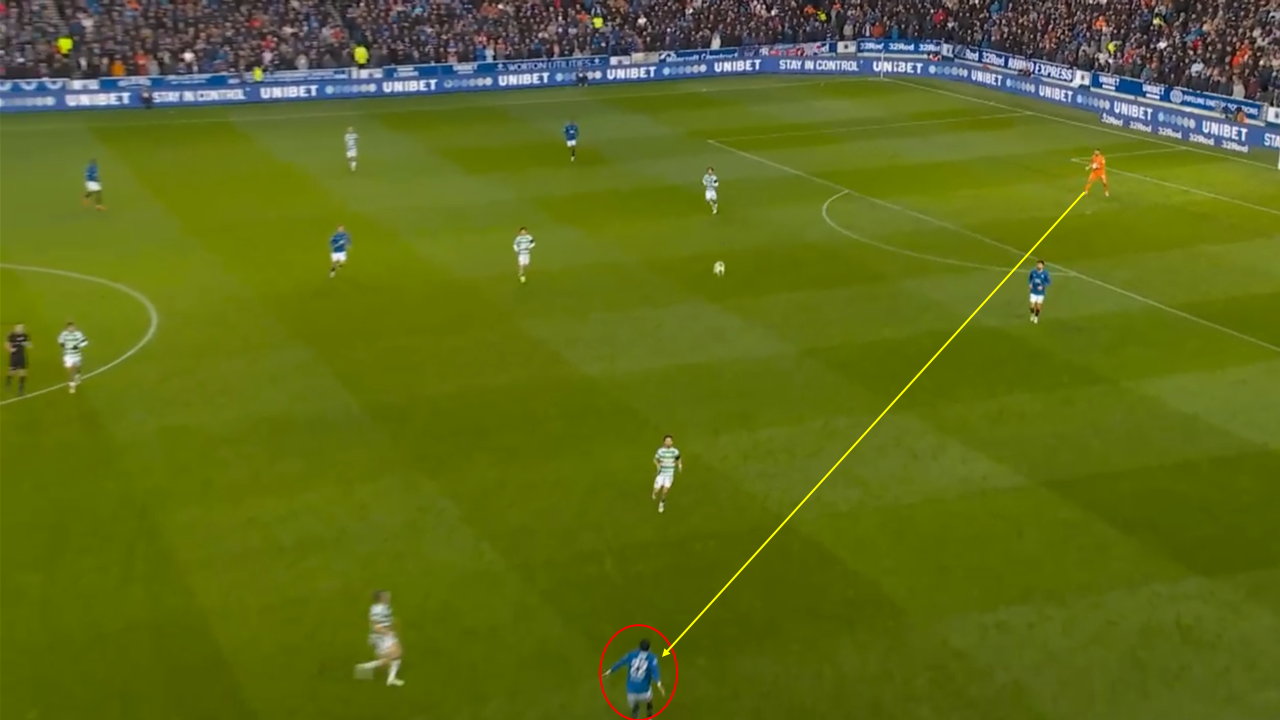
Here, Kelly plays a long diagonal ball to full-back Jefté.
The Rangers shot stopper often took a direct approach, deciding to play over Celtic’s press and avoid the risk of giving the ball away in his own half.
Rangers’ directness in attack was far more than just long balls played in hope.
They produced fast, intricate attacks that caused all sorts of problems for their opposition.
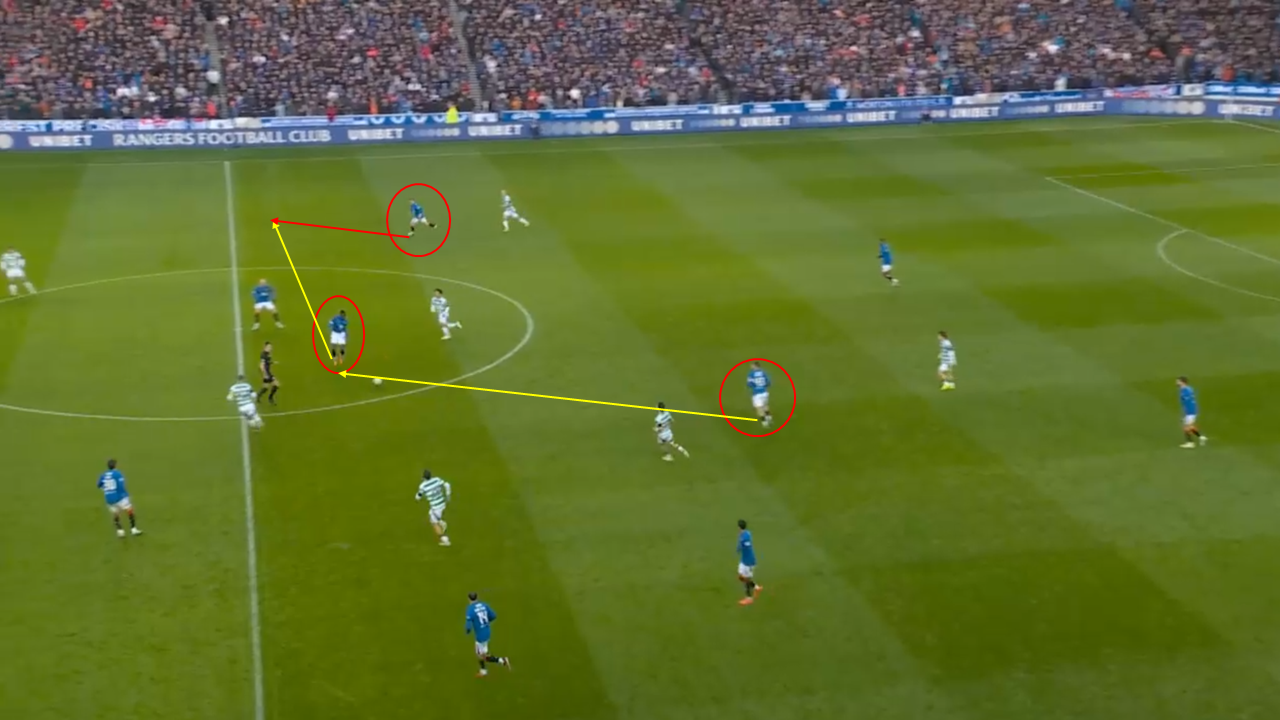
This example demonstrates Rangers’ intentions perfectly.
As the balls won back, Raskin plays the first pass of Rangers attack forward to the feet of Diomande.
The Ivorian takes the ball on the back foot and plays a pass into the path of Yılmaz, who’s making a forward run down the right flank.
These quick attacks often got Rangers into deadly positions where they flooded forward in numbers.
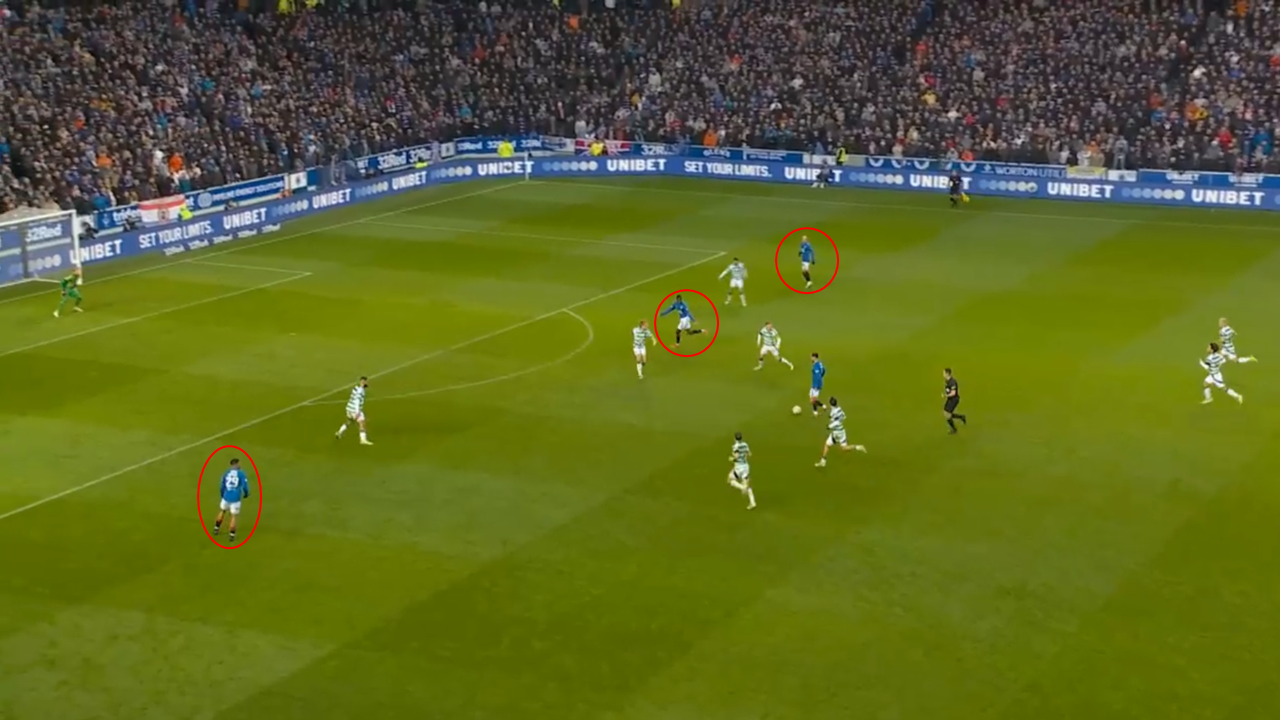
Here, Bajrami has got the ball. He’s been supported by three excellent runs.
Igamane and Černỳ are providing width, while Diomande makes a penetrating run through the middle.
Once they got into these positions, the Rangers looked to finish off their attacks with an effort on goal.
They had a remarkable 24 shots.
The most Celtic have ever faced in the Scottish Premiership since records began.
Rangers dominance is displayed when comparing this to Celtic who only had four shots all game.
Defending In The Final Third
Through their directness, pace and willingness to test Kasper Schmeichel,
Rangers were able to win comfortably.
Yet despite wholesale changes, Rangers’ defence played an enormous part in the victory,
An essential aspect was their ability to defend wide areas effectively.
Nicolas Kühn was a thorn in Rangers’ side during the League Cup final.
Nicolas Kühn Winger Actions
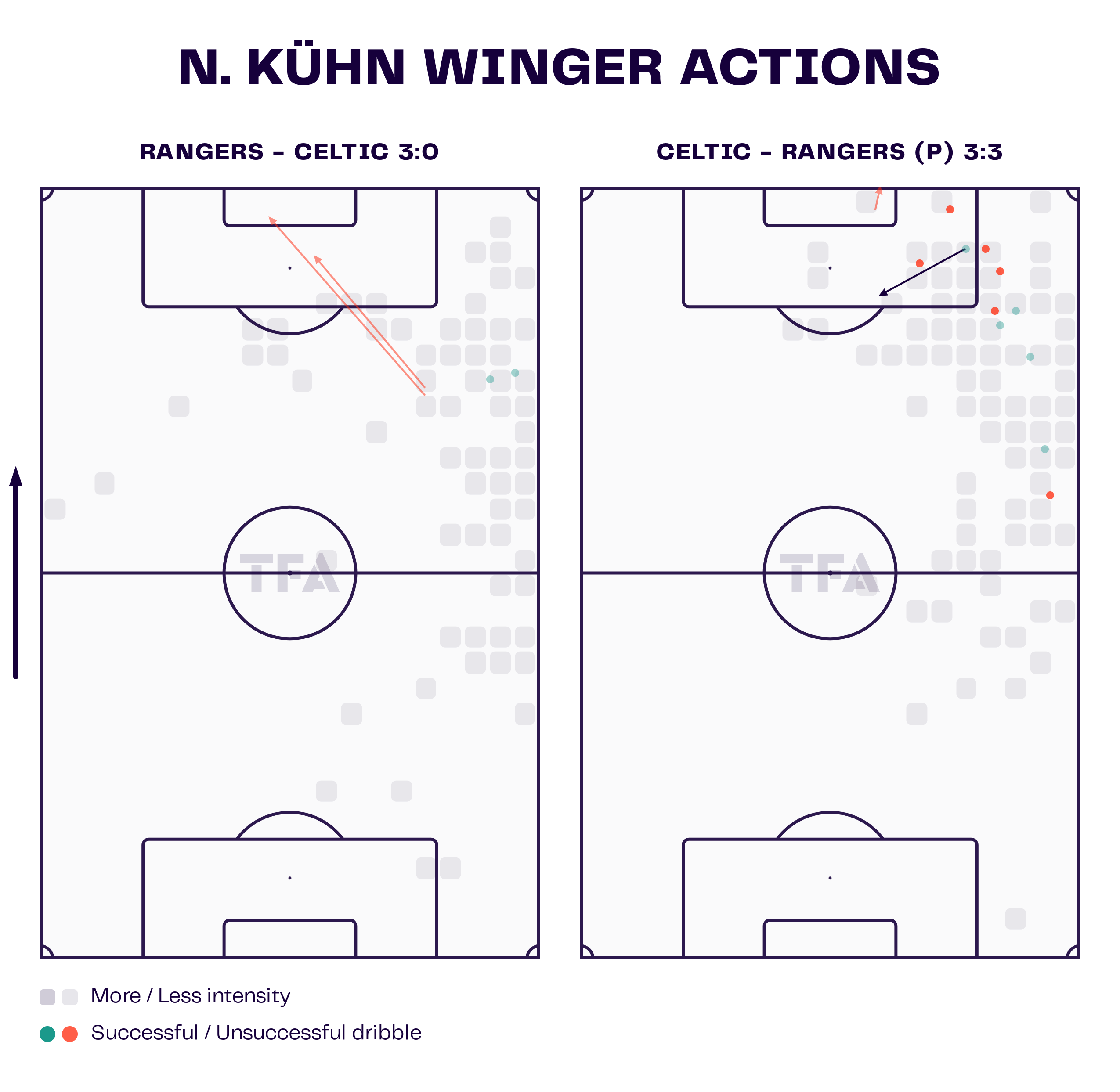
When comparing his actions from both matches, it’s evident that Rangers nullified the wide man.
The collective work between Rangers’ midfield and full-backs was the driving force behind, Celtic’s danger men having an uncharacteristically quiet match.
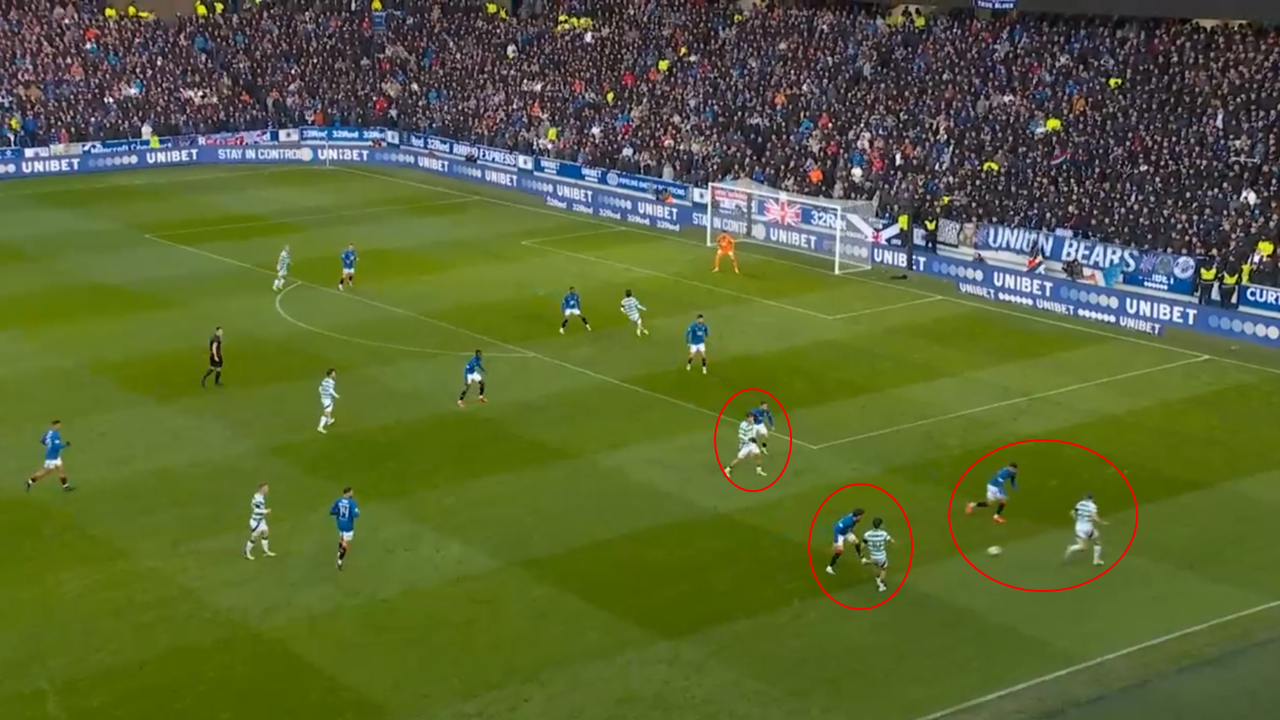
In this scenario, Hagi and Jefté have communicated effectively to ensure they defend effectively against Alistair Johnston’s overlap.
Raskin also carefully marks Bernardo to stop an overload from occurring.
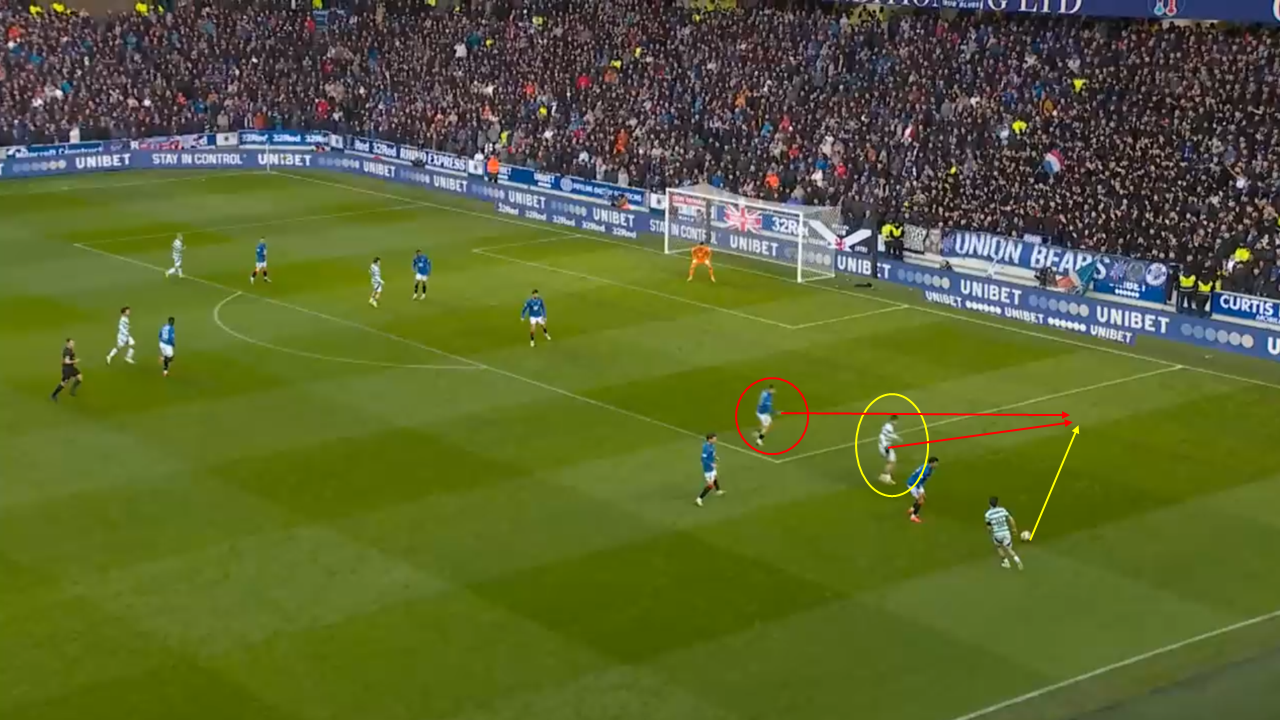
Likewise, here, Beranrdo makes a run trying to offer an option for Kühn.
Raskin follows him closely and puts a stop to the attack.
As much as Rangers’ full-backs played key roles, Sterling and Pröpper also put in commanding performances.
The centre-backs both were successful in over 65% of their duels.
Pröpper also made the second-highest number of interceptions in the match.
Both excelled when Celtic attempted to play ball in behind Japanese forward Kyogo.
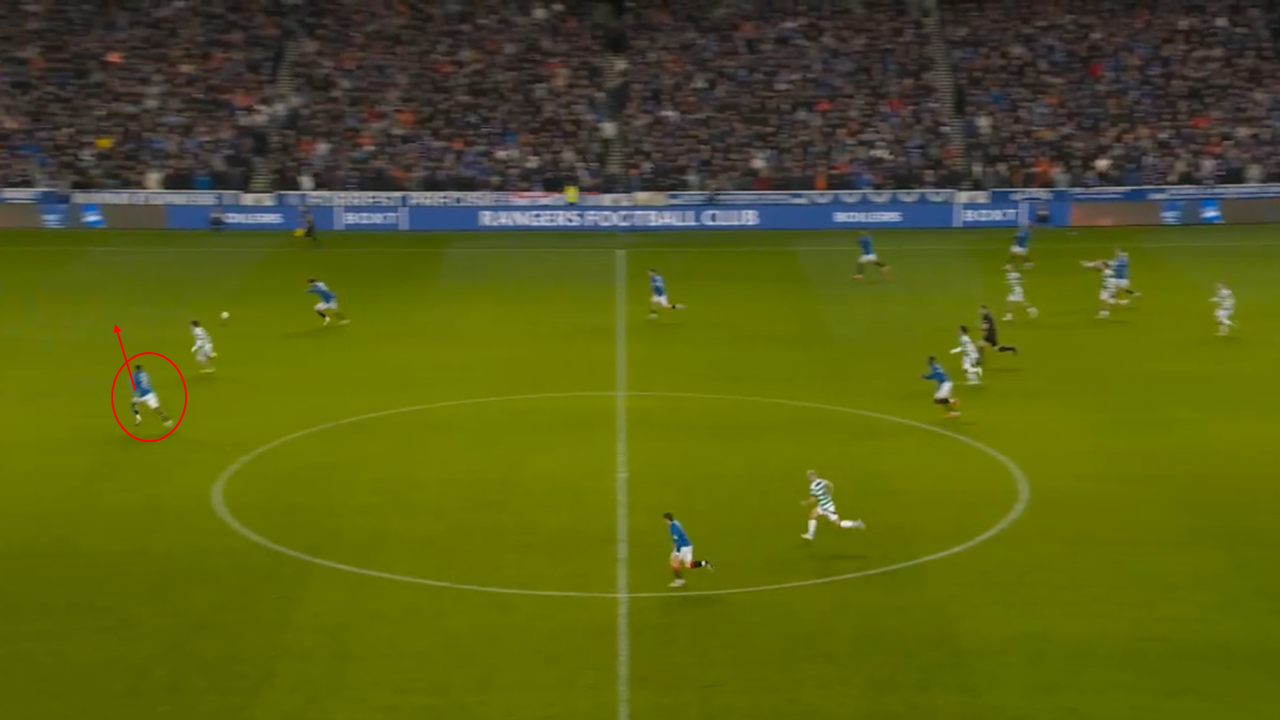
In this situation, Celtic aim to hit Rangers on the break.
A ball is played behind the Rangers’ backline into the path of Kyogo.
Sterling quickly gets across and follows the striker before making a vital challenge.
Pröpper was also aware of the threat to these types of passes.
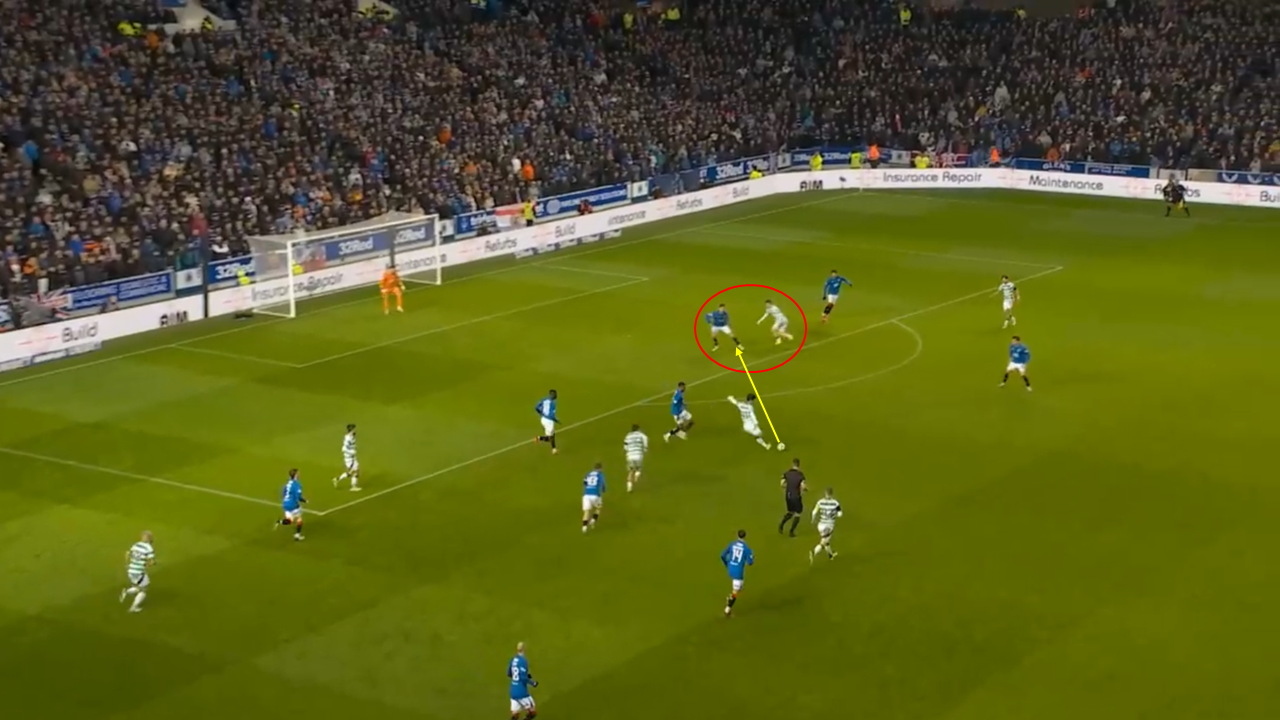
Here, Hatate aims to play a reverse pass through to his fellow countryman Kyogo.
Pröpper was fully aware of Kyogo’s location due to his excellent body shape and duly made the interception.
Celtic’s Lack Of Edge
Praise should be heaped on Rangers for finally getting the better of their rivals.
However, a critical eye must also be cast over Celtic’s abysmal performance.
A large part of Celtic’s performance was how sloppy they were in possession.
Their season average for progressive passing accuracy is 79%.
Celtic only managed to complete 62% of their progressive passes in this game.
This sloppiness in possession was seen in all areas of the pitch.
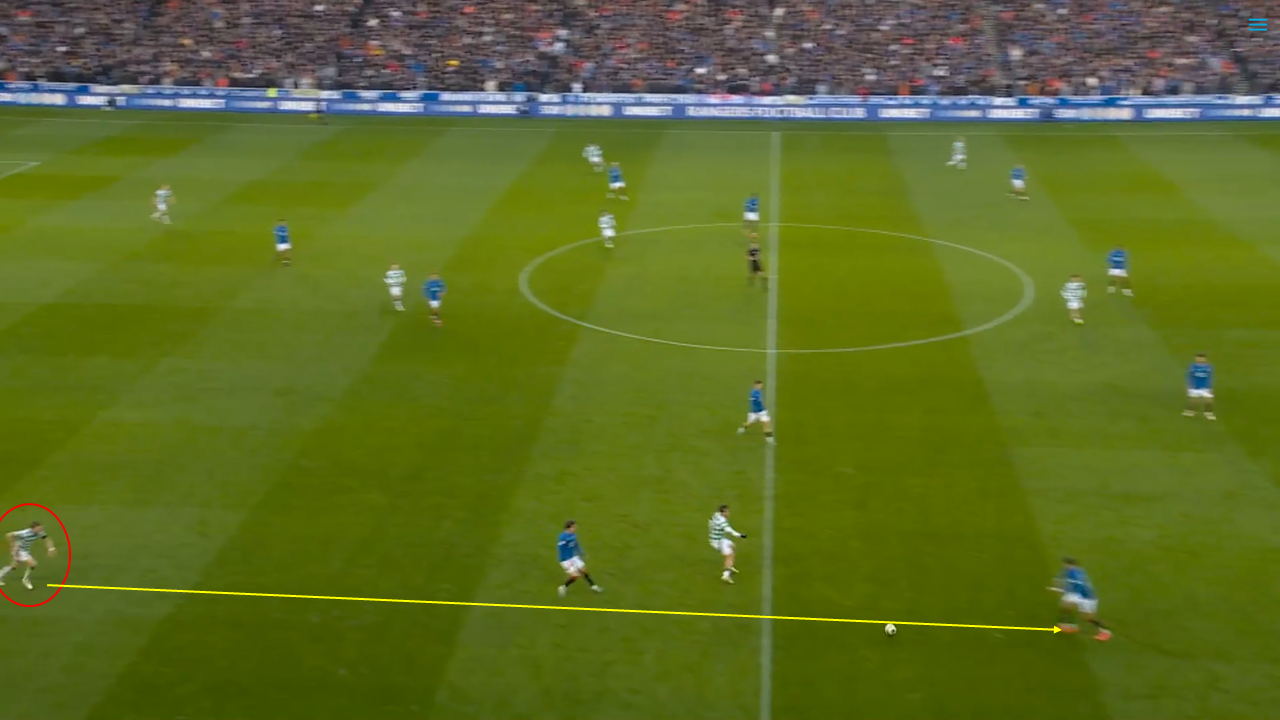
This example shows Alistair Johnston with the ball in his own half.
He aims to play a pass to midfielder Paulo Bernardo.
Yet it’s incredibly predictable and lacks the necessary weight and accuracy.
Jefté steps in and makes the simplest of interceptions.
One characteristic of Celtic’s game is their impressive combination play.
Both their accuracy when passing and lack of movement prevented them from executing anything that would cause Rangers issues.
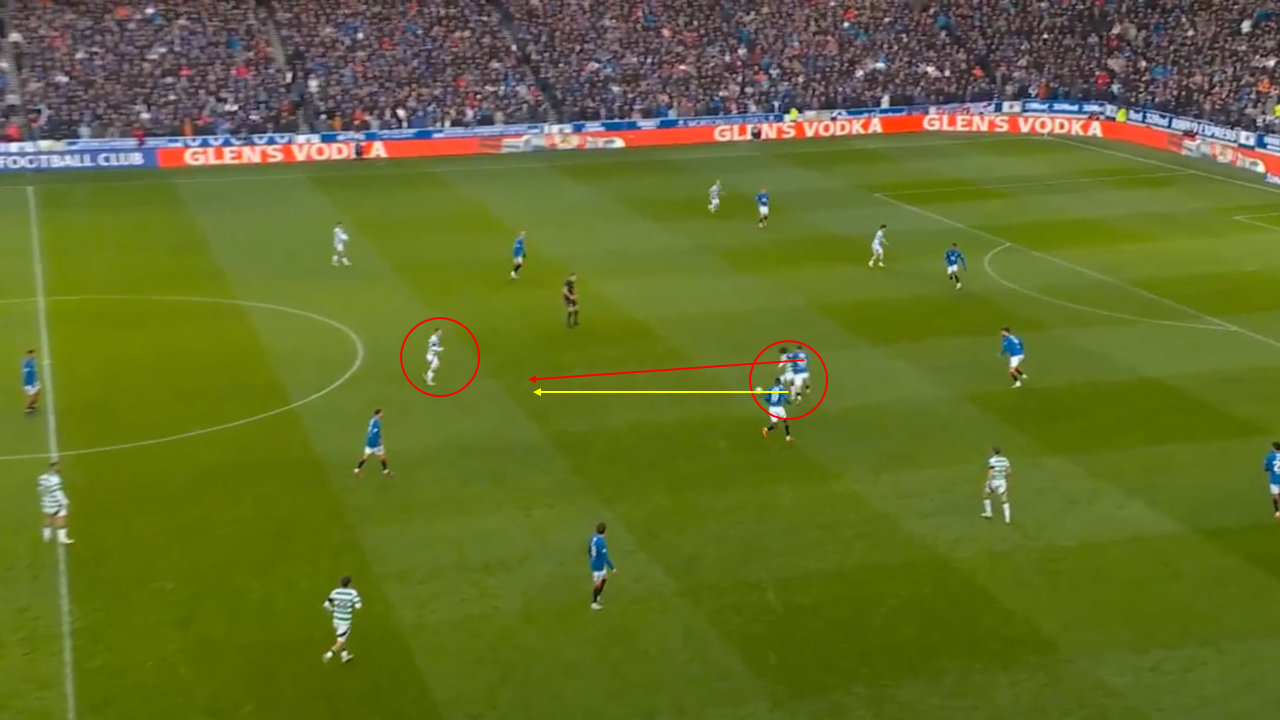
After Celtic have eventually broken the Rangers’ press, a ball is played forward and finds Reo Hatate.
His next pass was weak and played towards the flat footed Callum McGregor.
This allows Raskin to close Celtic’s captain down, preventing an excellent opportunity for Celtic to play forward.
Situations like the previous example were common.
Kyogo and second-half substitute Adam Idah failed to aid their team in these scenarios.
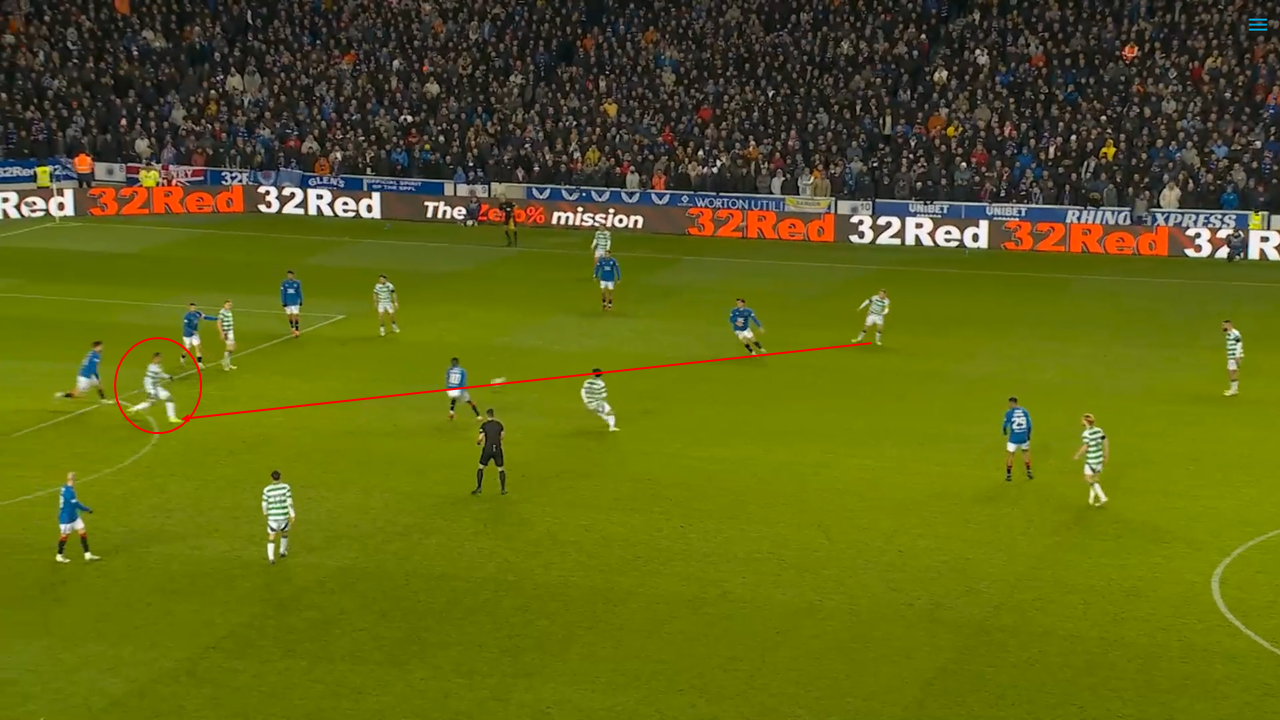
A ball is fizzed into the path of Adam Idah.
He then tries to flick the ball around the corner yet misses the ball completely.
Idah loses possession in a situation where he could have provided a platform for his team to attack.
Conclusion
Rangers will be under no illusion that the consideration of winning the league is still wishful thinking.
Celtic are unlikely to drop 11 points from now until the end of the season.
Rangers are also unlikely not to suffer from the inconsistent form they’ve produced all season.
However, Rangers will gain a belief that they can put in these types of performances against their great rivals.

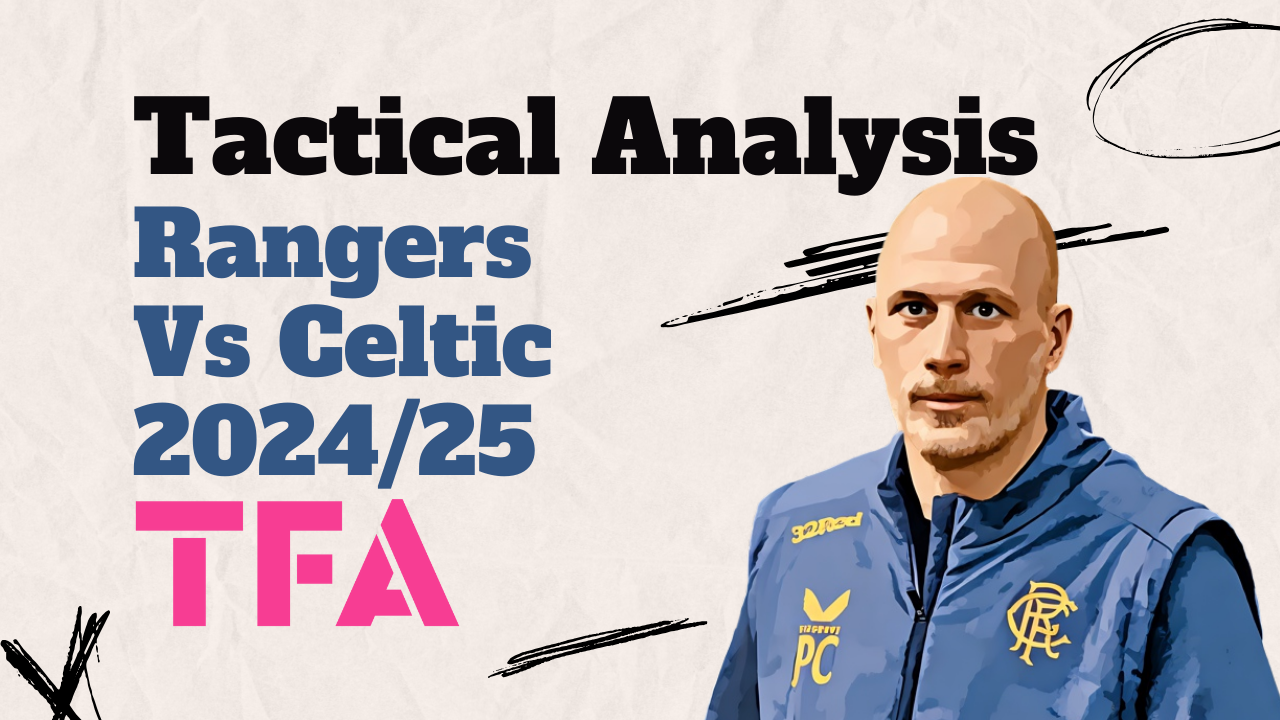



Comments